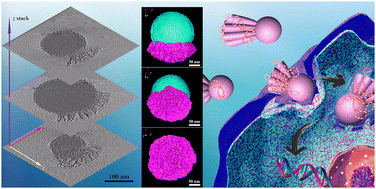Tailoring head–tail mesoporous silica nanoparticles for enhanced gene transfection†
Abstract
Plasmid DNA (pDNA) delivery has attracted extensive research interest due to its great potential in gene therapy. The design of efficient nano-vectors to promote cellular delivery and transfection of gene molecules is the key to success. Compared to conventional nanocarriers with spherical geometry, asymmetric nanoparticles have been well documented showing enhanced cellular uptake and drug delivery capability. However, the impact of asymmetric nanostructures on pDNA binding and following intracellular delivery performance has been less reported. Herein, asymmetric head–tail mesoporous silica nanoparticles (HTMSNs) with tailored tail lengths were synthesized and employed as nano-vectors for pDNA delivery. The nanostructures of HTMSNs were carefully characterized by electron tomography. The pDNA binding, cellular uptake and gene transfection capabilities of engineered asymmetric nanoparticles were compared with symmetric dendritic mesoporous silica nanoparticles (DMSNs). The results showed that the asymmetric morphology of nanoparticles promoted pDNA binding and cell internalization, where HTMSNs-66 with a specific tail length of 66 nm achieved the highest transfection efficiency. This study reveals the impact of asymmetric nanostructure on DNA interaction, and provides guidance in future designs of non-viral nano-vectors for efficient gene delivery.

- This article is part of the themed collection: Journal of Materials Chemistry B HOT Papers


 Please wait while we load your content...
Please wait while we load your content...